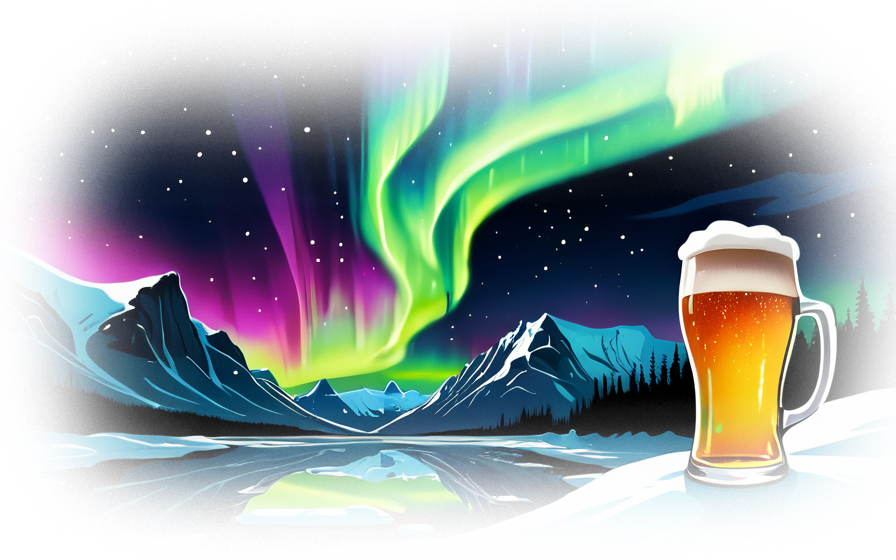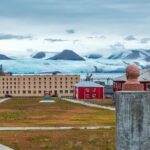Northern Lights 🌌 Aurora Borealis
Northern Lights
Aurora Borealis
The Aurora Borealis is an incredible light show put on by nature for free!
It’s a winter wonderland of snow, cold, darkness (as usual!), and an epic green spectacle moving in the sky.
Here are a few photos from several years of chasing the northern lights during the polar night (mørketid) in northern Norway.
A stunning, unified photo-documentary trilogy of winter polar expeditions to the north of Norway. I tried three times (twice by air and once by car), and I’m happy to say that I had three pretty good results! And as a bonus, in all cases, I also had a nice increase in beer statistics. Here we go…
Before we explore the fascinating world beyond the Arctic Circle, let’s take a quick peek at some basic concepts to help us understand our starting point. I may be a cultural ignorant and an absolute amateur in the field of everything above the average flight level, but I draw encyclopedic wisdom from the internet and/or sell as I have bought elsewhere (especially from Slovak colleagues who have been involved in the astro world for a long time). I’m so lucky to know them!

We shall commence with a brief theoretical exposition
You might have seen the Northern Lights mentioned in the news recently and wondered what’s behind those mysterious colours dancing in the night sky. This natural phenomenon, known in the northern hemisphere as the aurora borealis (in the southern hemisphere as the aurora australis) , is more than just an effectively spectacular effect. It’s proof that sunbursts farts can paint.
Hey Chat GPT!
What is the encyclopedic definition of aurora borealis?
A natural light phenomenon characterized by bright, colored lights in the sky in the polar regions. This phenomenon is caused by collisions of charged solar wind and magnetospheric particles with the Earth’s high atmosphere. These collisions cause the emission of light when the energy of the particles is absorbed by the atmosphere. Aurorae are most common in areas near the geomagnetic poles and can take on a variety of colours and shapes, from green to pink or purple, and can appear as quiet arcs or rapidly changing shapes and patterns.
Just to recap, aurorae are created when charged particles from the Sun reach the Earth, where they meet gases in the atmosphere. These solar particles are just like little travellers, zipping through space. When they reach our planet, they are drawn to the North and South poles by our lovely magnetic field. And this is where that amazing aurora you read about is created! When it comes to colours, green is probably the most common – and it’s produced when particles meet oxygen in the lower atmosphere. If the particles float up to the top and come across oxygen in the upper layers, the light will turn red. And for all you people out there who adore blue and purple, the hero of the show is nitrogen. It’s absolutely amazing and you can see it more than twice!
Although a snow-covered, frosty landscape under a starry sky accompanied by the Northern Lights may seem like a romantic idyll at first glance, it is important to remember that standing outside for ten minutes in the freezing cold with a camera is as far removed from fairytale winter. Tea in a thermos gets cold pretty quickly. The heating power of rum is not compatible with a steady hand and a sharp eye. Beer in a can also freezes pretty quickly, not to mention strong wind gusts.
Year 2019
Our first trip north for the Northern Lights started in early March 2019 in the city of Ostrava in CZE, where we met up with our Slovakian colleagues. We then headed through the Baltics, Finland, through city of Tromsø to Lofoten Islands and to the end of the world to the village of Å. From there, we turned around in the car park and headed back south for home. I’d like to extend my warmest greetings to Commander Tibor, the brilliant leader of our expedition and organiser of other incredible trips.
We made our way back through Sweden and Poland, ending up in Prague. An additional feature of the winter expedition in the car was the sliding door insulation, which was observed to lose its efficacy in insulating the surrounding environment at speeds in excess of 60km/h. However, the air-conditioning loophole proved an effective accelerator of the beer cooling process during the trips, transforming a potential disadvantage into an advantage.
We were delighted to experience the joy of greenish skies for the first time in the northern Finnish village of Kilpisjärvi. Since then, we’ve been lucky enough to experience the green sky through the cities of Tromsø, Lofoten Islands and Abisko NP in Sweden. The first trip was a complete success! It’s not just about luck, but also about the chief planning responsibly.
For example, in Svalbard at the bar in a taproom we witnessed a question: “when (during the polar day) will we see the Northern Lights? We were told it was here somewhere!“. It would seem that the blond lady at the bar received a response that was not entirely what she had hoped for. Such is the unfortunate fate of those (mostly Brits) who are not adequately prepared for such situations. It’s always worth planning ahead, but of course the weather can have a big impact as well as the season itself…
Winter in Lofoten
To give you a bit more than just pictures of the northern lights, I’m attaching a few photos I managed to take along the route. On the way back, we had the amazing opportunity to meet a Swedish friend at a gas station in Uppsala at 4am! We had one coffee, took a selfie together, and then he went on to work, while we drove further south. I have to say that Gdansk was a bit of a surprise, at least for me. A truly delightful town, with a beautifully preserved centre and a magnificent water canal like from the Witcher 3 PC game. At the heart of it all stands a grand church, with a staircase that winds its way up to the rooftop – a truly magnificent sight to behold…
We were so lucky at Tromsø – twice as lucky, in fact!
Outside, the aurora borealis was shining brightly in the cloudless sky, and at home this beautiful rainbow was smiling at me.
I enhanced my enjoyment of the night sky by eliminating the entire range of colors, from bright to dull.
Year 2022
This was our second visit to Tromsø in 2022, following a quick one-day stopover from Spitsbergen (the sun still shines there in summer, even at night). In winter we stayed in the area around the Paulseng bus stop where we were not only lucky with the aurora borealis, but also with the weather in general, which was able to produce interesting colours on the horizon even in a very short time of sunshine.
Just to give you a rough idea, the sun rises at around 11am and sets just before 1pm. One unexpected highlight of this year’s trip was getting stranded with the car in a ditch not far from the ‘Beware of moose and reindeer‘ sign. Thankfully, a local fella with a Jeep and a rope came to our rescue. It’s not uncommon to get stuck in the winter in Norway. Falling into a ditch in winter in Norway is a common experience.
Time-lapse video of the aurora borealis
Year 2023
Guess what! The last (third) year of the aurora chase took place in the same place as the previous year. On the day of our arrival, something incredible happened. A meteorological anomaly resulted in the accumulation of more water and clouds over the base, creating a spectacular rainstorm that accompanied us until the second day. The weather stayed pretty much the same, but it got a lot colder and the rain turned to heavy snow. As the evening approached (I mean our normal 8pm± evening), the clouds disappeared to make way for the start of the carnival!
We saw the Northern Lights, drove around a few islands, fed a few reindeer somewhere on a reindeer ranch and finally washed it down with local beer at local prices (1 medium NOR beer costs as much as 7 CZE lagers). If you think a photo with a tent means an unforgettable romance, think again. The romance will soon be overshadowed by the feeling of a burnt-out stove and the unfortunate thought that no one but the tent’s occupants have to start it again. I can’t say I have any empirical experience here. I sell as I bought from a local…
On the day of departure, the weather surprised us with a spectacular display of snowfall at night and a breathtaking sunrise/sunset.
From what I can get from EXIF data, this photo was taken at 10:45 in the morning.
The End
As we wrap up our exploration of the Northern Lights, I want to thank you for your time and interest in this celestial phenomenon. The Northern Lights have been captivating humanity for centuries with their breathtaking colours and mesmerising dance across the night sky. It has been a real pleasure sharing this magic with you. Thank you for being part of this journey with me.








































